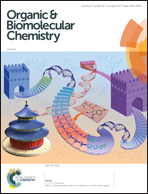Synthesis and conformational analysis of peptides embodying 2,3-methanopipecolic acids†
Abstract
The conformational analysis of linear and cyclic peptides incorporating 2,3-methanopipecolic acids (or Cyclopropane Pipecolic Acids, CPAs) as conformationally constrained α-amino acids is reported. Compared to peptides containing proline or pipecolic acid, a striking increase of the cis isomer (42–92%) around the CPA amide bond is observed, both in water and organic solvents, when these unnatural amino acids are embodied in linear amino acid sequences. The rotational barrier around the same bond in water was calculated, giving results comparable to that for the prolyl cis/trans isomerization. In organic solvents, CPAs at the i + 2 position of a peptide induce the formation of a type VIa β-turn secondary structure. When incorporated into a cyclic peptide, the cis geometry around the 2,3-methanopipecolic amide bond still prevails and, in the example studied herein (a cyclic RGD-containing ligand of αVβ3 integrin mimicking Cilengitide), conservation of the backbone geometry and side chain spatial orientation of the native peptide is also found. Given the importance of the proline cis/trans isomerism in many biological processes, CPAs could be useful as proline mimetics for probing protein–ligand interactions and generating novel bioactive compounds.



 Please wait while we load your content...
Please wait while we load your content...